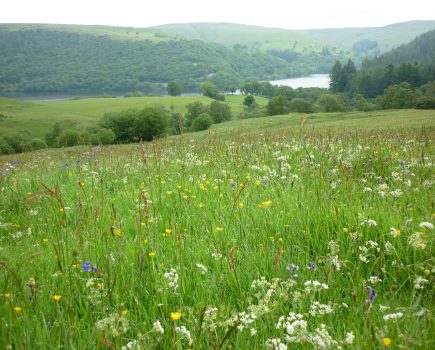How will we grow food when the oil runs out? One option is to follow nature’s lead and create forest gardens, says ANNA GREENWOOD
The television documentary A Farm For The Future on BBC2 early this year inspired gardeners, growers and farmers across the country. Wildlife film maker Rebecca Hosking looked at her family farm in Devon and its sustainability in the future. She explained how the approaching energy crisis is putting pressure on farmers, forcing them to take stock of their practices and the use of fossil fuels. Experts described how we are approaching Peak Oil, where the amount of oil being used is exceeding the amount of new oil that is being found. The Soil Association, for example, predicts an oil and energy famine by 2013. Yet much of what we eat is dripping in oil, from the ploughing of the fields with diesel tractors, sowing seeds, using fertilisers, herbicides, pesticides, harvesting, processing, packaging and delivering – all of this needs oil driven processes. The question is, then, how can our food production become fit for the future? The key message from the documentary was that farming will change forever.Before mechanisation, traditional processes required much labour from both people and animals. Contemporary farming methods require less manpower, but still call for a lot of hard work for little money. The average age of farmers in Britain is 60, and there are only 150,000 left. British farming is a dying industry. Selling farmland for development is an attractive way of making a lot of money – but is hardly the answer if we wish to sustain our environment and food production. The UK has long been a net importer of food. We import food from a wide range of countries globally and this diversity, DEFRA claims, gives us greater food security and reduces our risk to a disruption in supply.[1] But another view is that we are in a vulnerable position as the cost of processing and supplying goods increases. How much better would it be, in the long run, if we changed our eating habits to meet what we could sustainable grow ourselves?According to leading ecologist Richard Heinberg, of the Post Carbon Institute, we have waited too long to research alternative energies and they will not support our unsustain- able way of life. Ten calories of fossil fuels are used to produce one calorie of food in the industrial world. Whilst crop yields have tripled in the last 50 years, this has been at the expense of fossil fuels. We need to find a new way of feeding ourselves.
The forest garden conceptWhat changes can we, as smallholders, make to reduce the reliance on fossil fuels and food imports? Few of us are in the position to change the way this country imports and exports food, but we all have access to land, and we all have the desire to grow. We can change what we eat, and change how we grow our food. The less we disrupt the soil, the greater nature’s diversity in wildlife and the healthier the ecosystem becomes. But how do we do this? The energy in current farming is spent in preventing agricultural land from turning back into its innate state. By looking at the natural ecosystem, and what the landscape wants to do naturally, we can design our growing around a low energy, ‘natural’ system with minimal work by humans, no inputs from outside of the system and no waste. The natural landscape is covered with trees, hedgerows, shrubs, climbers, ground cover and, beneath the soil, is the root zone. Each plant has a function in the system, be it to feed the animals or to feed the soil. Plants grow upwards as well as out. This is how the landscape wants to live. The same principles can be applied to growing edible plants. Within each layer of plants is a wealth of wild food. Tall trees provide edible leaves, nuts and fruits. Shrubs provide more fruits and nuts. On the ground are aromatic herbs, perennial leaves and other functional plants as well as those that suppress weeds. This natural garden is a forest … a forest garden.In domestic gardens, each of these layers is grown separately: an orchard, a vegetable garden, a herb garden. Within a forest garden, however, these are all grown together on the same piece of land. Gardening becomes easier once the plants are established since, with careful planning, they work in harmony with each other. The natural cycle of life in a forest garden is in contrast to the annual work of digging, sowing, fertilising, ‘improving’ and ‘removing’ of the traditional linear format.
Designing The Future …The key to a good Forest Garden is in its design. Around that you can incorporate your own ideas of permaculture, horticulture, or any other culture in which you believe. The reason that design is particularly pertinent here is because these plants will be in place for a long time. The design planning can be split into a number of steps [2]:Collecting informationIt is invaluable to study the site through each day, through each season and through different weather patterns. From this you can piece together which plants suit which situation, what the land needs, as well as what you need. What is nature telling you about her land? Where are her natural water sources? What grows well already, and what doesn’t? What is the regional climate, and what is your micro climate? Are there slopes, damp areas, areas prone to flooding, frost pockets? Where is it shady and where is it sunny? How does the land lie to the prevailing wind, and what shelter is there? What is the soil like? Awareness of the natural lie of the land gives a greater understanding of what can be achieved. Also consider foot passage – where you walk to access different parts of the garden.
RecordingCreating a scale base map gives you the ability to look at the bare bones of the space. It contains information on existing structures, traffic routes, and any other information that you want to put on it as the skeleton for the design. Creating a diary records the information being gathered in ‘collecting information’ above. Photographs are also useful. The records you produce allow you to be aware of the space and really get to know it.
EvaluationIn getting to know the space there may be structures and plants that need to be moved or removed. Also consider what you want from the space. The key requirements for the space differ from person to person. My wish list would include:Minimal maintenance;Fruit and perennial edibles; Minimal annuals, and direct sow only;Encourage pollinators and other wildlifeYour own list will differ according to what you want from the space and how much time you have to spend on maintaining it.Next consider what sorts of plants you want. Start with the largest ones, the tree layer, then work on shrubs, then ground cover and roots. The wish list for plants for my garden would be:Trees – apple, plum, pear; Shrubs – currants, gooseberry, elder;Ground cover – strawberries, Nepalese raspberries, salad burnet, herbs;Direct sow annuals (these make use of space whilst trees and shrubs are maturing) – poached egg plant for bees, salad leaves, nasturtiums;Wildlife – ivy in shade on fence (good for autumn nectar, winter berries, hibernating and nesting animals);
DesignBy now you have a good idea of the space and what you want from it. The next task is to fit the plants into the space available. The first stage is to work out the size of the trees. A dwarfing apple on M9 rootstock will grow to a spread of 2.5m to 3m. A plum on Pixy root stock will grow to the same spread. The use of coloured card cut to scale and placed on the plan enable you to play around with spacing. Allow space between the final canopy spread so that sunlight can penetrate the lower levels. The more ‘edge’ you have, the more you can grow (edge can be path edge and shade edge). After looking at the spread of the tree layer look at the spread of the shrub layer and repeat the process. Move the pieces around on the page considering the information collected in the initial phase. The pieces can be held on with blue tack so that they can be moved easily. Once these are in place, continue with the other elements of the design until you are happy with it.After good design and planning comes implementation. Splitting the tasks into bite sized chunks makes them more enjoyable and achievable. Cost and source items, and establish your time frame and time constraints. Planting is best done between late autumn and early spring for most plants, and annuals require sowing and maintaining from spring through summer. This is now a forest garden of the future.







